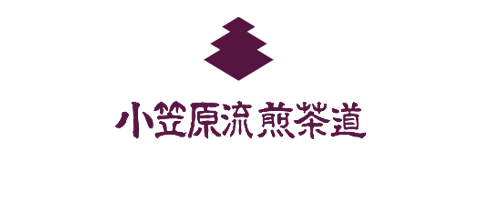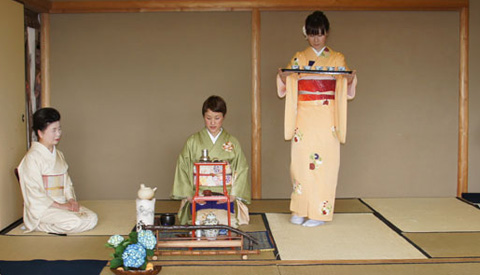

[Japanese]@[English]@[Chinese]@[French]
An Introduction to Tea Ceremony
Written by Head Tea Master of
Ogasawara Sencha Service School
Contact:
losangeles@Hiroshi Yamaguchi
yamaguchih@earthlink.net
uThings guests should know before attending a tea ceremonyv
ySencha-doz
Sencha-do(1) is different from Matcha-do(2), the latter using powdered green tea, the former using Japanese tea leaves and hot water kept at the right temperature. The Japanese tea leaves and hot water are put into a tea pot and poured into tea cups. Japanese people use this method in their daily life to drink tea.
Matcha-do uses different kinds of tea and utensils, and is a different temae(3) in contrast to Sencha-do. Matcha-do was popular as an education among the samurai. On the other hand, Sencha-do spread from the experts in poetry, literature, painting and calligraphy, down to the general public by enjoying a conversation over a cup of tea.
Although there are differences of utensils, manners and histories between Sencha-do and Matcha-do, they are the same in terms of treating guests sincerely and having them enjoy drinking tea. Not only are you able to quench your thirst but also calm your mind, develop your sensitiveness, and feel the ties with people in your heart through the Ogasawara ryu Sencha- do(4).
Manners are regarded important in Ogasawara style compared to other many styles of Sencha schools. Its manners are based on Ogasawara Manner Service School, which has the longest history in a field of manner schools in Japan, made in the Kamakura period (around 1185-1333), changing and improving its manners to fit modern days. Therefore, you can feel the mind and beauty of the hospitality through their performance.
yGuestsz
It should be noted that it is important to remember to cherish Wa(5), or harmony among guests in a tea ceremony.
After all of the guests take their seats, they exchange greetings. First, the syo-kyaku(6) bows and says, gTakai tokorokara shitsurei shimasu (I am humbly thankful to be a representative of all of you)h to the other guests with modesty, and then they bow in response to the syo-kyaku and respond with gGosho-ban yoroshiku onegai shimasu (We are honored to accompany you).h
The syo-kyaku represents all of the guests and speaks directly with the host, and will sit closest to the tokonoma(7), where a vase of arranged flowers is displayed to show where the principal guest sits.
After exchanging greetings among the guests, the principal guest moves the vase to his or her side where the other guests can see.
Before starting the performance, the host makes a short speech expressing appreciation to the guests for coming to the tea ceremony, with the guests replying to the host about their gratitude for being invited to the ceremony.
Once the performance starts, the dai ichi do-ji(8) serves a bowl of tea-cakes. The dai ichi do-ji then sits next to the host so that he or she can assist the host.
The syo-kyaku tells the host that he or she will start to take his or her own sweets when the time is right.
The syo-kyaku takes a sweet first, puts the bowl on the side nearest to the next guest, then bows and says, gOsakini (Excuse me for taking first)h to the next guest, and the following guest bows in reply and responds with gDozo (Please).h
When your turn comes, hold the bowl with both hands and put it in front of yourself. Bow to the host and say, gOkashi wo itadakimasu (I will take a tea-cake).h All the guests need kaishi(9) to place the sweet on. One piece of the cake is moved to the kaishi paper from the right side to the front with chopsticks.
These chopsticks are then wiped clean with the top right corner of the kaishi paper before placing them back on the bowl again. Put the kaishi paper with the sweet on the top to the opposite side where the principal guest is. Using both hands, move the bowl in between you and the next person.
In Sencha-do, guests can enjoy two cups of tea in a tea ceremony. The sweet is then eaten after the first cup of tea is finished because the first sip is the tastiest due to its great smell and flavor.
The helpers carry the tea on a tray over to the front of the guests. The helpers hold the trays well elevated so as to not to get their breath or hair into the tea.
When all the tea is served to the guests, they bow and say gCho-dai shimasu (Let us enjoy a sip),h and the tea is finished in about three sips.
After finishing, the cup is admired (its designs on the side and bottom), set upright, and the saucer is admired as well. Guests in a tea ceremony can also enjoy a sense of the seasons and the hostfs hospitality from the utensils, equipment, sweets and flowers that the host worked hard to prepare.
Finally, you eat your own sweet. Once this is done, wipe your mouth with the kaishi paper before putting it back into your pocket. When eating the sweet, the dai ni do-ji(10) takes the used bowl and collects the first cups of tea, carrying them to the Mizuya(11).
When the second cups of tea are served, the guests repeat the process from the first cup of tea.
The second cup of tea has a deeper, bitter taste than the first one. However, you may feel it tastes good because the depth of the tea blends with the Japanese sweet you ate before drinking the second one. Please enjoy the tastes by comparing the two teas.
After a performance finishes, the host expresses his or her gratitude to the guests for coming to the ceremony. The guests then bow in reply to the host and make a short speech of appreciation.
After that, guests exchange greetings once more. The syo-kyaku says, gTakai tokorokara shitsurei shimashita (I was honored to spend time with you)h to the other guests. The other guests respond with gGosho-ban arigato gozaimashita (Thank you for accompanying us)h to the syo-kyaku.
The guests also need to be aware of the manners. The more the guests understand the manners, the more comfortable they can become.
yTemaez
Japanese tea is generally called Sencha and it is classified as Gyokuro(12), Sencha, Ho-jicha, Ko-sencha and others. Gyokuro has the highest quality of all the Japanese teas. Therefore, it is often used in Japan not only when treating important guests but also when having a tea ceremony in Sencha Service.
Before a performance starts, the host washes his or her hands, bows toward a tea room, then sits on his or her heels at the hostfs seat where it is in front of utensils setting. At this time, the host straightens the kimono(13), checks the sitting position, bows to the guests and spreads the hizabukusa(14) on his or her lap. This purple fabric is used to keep hands from coming in contact with the kimono during a performance so that the hands can be kept clean.
The host must complete the standard arrangement to get ready to make tea, taking out utensils from a tray or a shelf, and setting up them at appropriate positions.
The host pours hot water into the chawan(15) and cleanses the chawan with the chakin(16). This movement is called kiyome(17). Of course, the utensils are all clean, and it creates a purified atmosphere.
After kiyome, the host starts to make the first tea. Hot water is poured into the to-rei(18) to adjust its temperature to about 45, which is the best temperature for gyokuro.
While cooling hot water, pick up the suichu(19), pour water into the to-hutsu(20), and put tea leaves into the kyu-su(21). Finally, pour hot water in to-rei into kyu-su. In order to make the tastiest tea, it needs to brew for about 90 seconds, while emptying hot water of chawan.
Pour infused tea into chawan in one slow continuous movement from left to right and back. At this point, the host needs to pour the tea to the last drop, and make no differences about quantity and concentration of all the teas. Then, wipe the bottom of the cups and put them on the chataku(22).
When finishing making the first tea, the dai ichi do-ji carries it to guests and then the dai ni do-ji brings substitute cups for host to make second tea. Host repeats the process from the first tea to make second ones.
After making the second tea, utensils are cleansed, and put back to their original positions. Lastly, the host puts the hizabukusa back into the kimono, bows to the guests, and leaves the tea room.
Although there are more than 50 patterns of performances in Ogasawara ryu Sencha- do, the basic movements are almost the same.
The series of procedures for making tea and putting the things away is very efficient without unreasonable, useless and uneven movements so that every single movement is truly beautiful to see in a comfortable rhythm formed by consistent motions and pauses.
In a comfortable atmosphere made by host and guests, people can sense various things through one cup of tea and that can make people develop their mind spirits. Wa is the most important mind sprit for the Japanese, and people can learn these such as hospitality and manners through Sencha-do.
1 ÷¹FSencha-do
2 ¹FMacha-do
3 _OFtemae (a sequence of movement for making and serving tea in front of guests.)
4 ¬}´¬÷¹FOgasawara ryu Sencha- do (Ogasawara Sencha Service School)
5 aFWa (harmonious group spirit)
6 ³qFsyo-kyaku (principal guest)
7 °ÌÔFtokonoma (recessed alcove in a Japanese-style room)
8 æê¶qFdai ichi do-ji (first assistant)
9 ùFkaishi (packet of papers ;kaishi papers)
10 æñ¶qFdai ni do-ji (second assistant)
11
®Fmizuya (preparation room)
12 ÊIFgyokuro
13
¨Fkimono (traditional Japanese wear worn)
14 GåÞÑFhizabukusa (purple square of fabric)
15 qFchawan (tea cups)
16 ÐFchakin (small napkin to cleanse utensils)
17 ´ßFkiyome (purification)
18 âFto-rei (water cooler)
19
Fsuichu (pitcher)
20 ¦Fto-hutsu (boiling hot water)
21 }{Fkyu-su(tea pot)
22 ïFchataku (saucer)